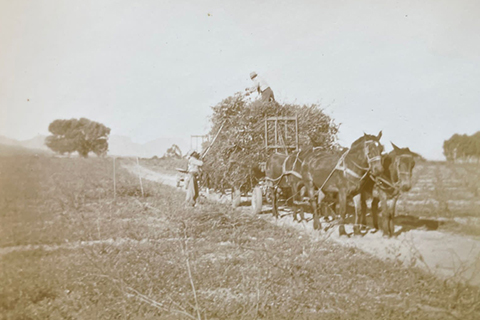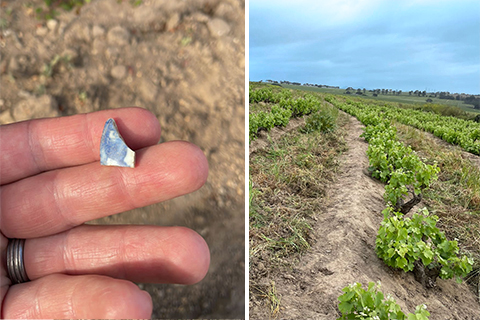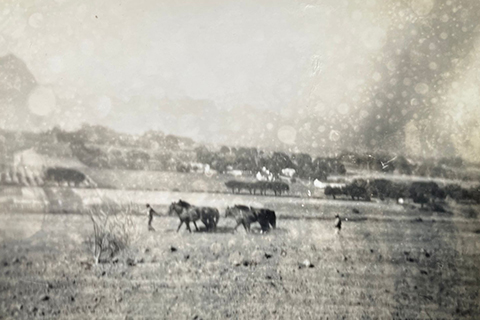
VOGELZANG
We are excited to introduce you to our new small-batch, limited release Cabernet-Cinsaut blend, Vogelzang. Delicate, elegant and perfectly matured showcasing two varietals blended in the traditional South African context illustrating their magnificent ageing potential. A wine that bottles the untold history of the Helderberg.
Vogelzang sings the untold history of the Helderberg
Vogelzang, meaning ‘the song of the bird’, was one of the original title-deeds of the Cape, granted over three centuries ago (17 May 1702) to one of the first Free Burghers of Stellenbosch, Sara Tas. The farm carved up Helderberg’s Sinai Hill, colloquially known as Berg Sinai; which has played backdrop to much drama throughout the subsequent churn of time; from irreverent reverends, early feminism, political insubordination and even magical, healing clay. It was also one of the first areas of the Cape to be planted with vines for winegrowing, predating the historic Vegelegen estate, and coming just after Groot Constantia was planted.
Bottling this heritage in the contemporary era is Le Riche Wines with cabernet-cinsault blend, the Vogelzang 2014. Premium cabernet sauvignon specialists the family-owned winery has always traditionally sourced high quality fruit grown by farmers they have long-term relationships with. This limited release is no different, sourcing both cultivars from Vogelzang’s original boundaries. The wine also serves to showcase Le Riche’s commitment to the advancement of Stellenbosch cabernet; and in particular heroing the heritage blend of cabernet and cinsault, largely unique to South Africa.
“When the sun rises over the Helderberg the first rays hit the top of Sinai Hill and shimmer gold on the granite as the sun blankets down,” shares one of the Helderberg’s most knowledgeable growers, Bernhard Bredell. Bredell is also the producer of his own-label Scions of Sinai, hewn from these same hills.
Bredell gestures to the ‘koppie’ through the wide windows of Le Riche’s tasting room. “When the light hits the hill a burst of birdsong accompanies it, the music weaving through the old fynbos corridors of taaibos and renosterbos. I suspect that’s the reason the farm was called Vogelzang in the first place.”
Seventh generation grower and winemaker of the area, Bredell's family has farmed this land since the 1860s. At one point ownership of Vogelzang was under their auspices. Part of the original delineation and still under Bredell holdings is the Rustenhof farm, where the 1973 bushvine cinsault for the blend is grown. The boundary forming part of where Sara Tas's title-deed was set.
From this vantage point at Le Riche the eastern slopes of the Helderberg are perfectly framed. Bredell describes the bygone boundaries of the Vogelzang farm, navigating from trees to water towers, painting a picture of early viticulture as he does so. The Helderberg with its maritime windy conditions and granite duplex soils is prime wine-growing terroir. Due also to the good winter rainfall and loose ‘drainable’ soils on the slopes dry farming is widely practised now (as it was then).

In the early 1700s 12 Free Burghers were granted title-deeds of this promised land. The conditions are not dissimilar to that of the Cape’s ground-zero for viticulture, Constantia. “If you look at the distances from the ocean and the resulting maritime influence as well as the granitic band in the mountains, it’s very similar,” muses Bredell. “It’s almost as if they had already figured out the requirements for high quality winegrowing and they knew the Helderberg would deliver.”
Coming out from places like the Netherlands, the Free Burghers had to sign a 20-year lease to farm the land they were ceded. “Imagine the heart these people must have had to make this commitment?” says Bernhard rhetorically.
“What’s even more amazing is that Sara Tas was the first, and only woman, I’ve ever read about to be granted a title-deed on her own without a husband.” Part of the untold history of the Helderberg, records show that Sara was a land-owner in Stellenbosch, way before her more famous brother, Adam Tas of Meerlust. Adam, it is said, came to Vogelzang to visit his sister, and notes in his journal from 1706 refer to him staying over at the farm with a notation also to ‘Berg Sinai’. Hendrik Cloete, one of the original owners of Constantia later acquired Vogelzang from Sara Tas.
There were characters aplenty farming these granitic hills. Neighbouring Vogelzang, Reverend Kalden was granted a farm in 1699 – this was done apparently for him to convert arriving slaves to Christianity. The farm was on the south-west slopes of Sinai Hill where Vergenoegd is now.
Sinai Hill’s majestic sunrise greeting may also be a clue to how it got its name.
Priestly duties aside Reverend Kalden was the first to cultivate vines here with a grant of 11000 vines. “We speculate he named it ‘Sinai’ for how it reminded him of Mount Sinai in the bible where the ten commandments were bestowed,” elucidates Bredell.
“He was later relieved as reverend for dereliction of his duties. The story goes that mid-sermon his wagon came past with barrels for export, so he left the church to 'quality taste' his wines before they were shipped off.”
It was also on this hill that various farmers were arrested for conspiracy against the government for not wanting to acquiesce to the punitive legislation of the time , which saw them having their land taken away, and then languishing in the Cape’s dungeons instead.
More amusingly it was also to the Helderberg where people flocked en masse for the healing properties of ‘magic clay’ sinking their feet into the mud between the vines. “This was on my great grandfather’s land in-between Rustenberg and Vogelzang,” says Bredell. “We always joke that this was the actual start of the Stellenbosch Wine Route because he had to start charging entrance to manage the crowds.”
Looking at the green hills now, the granite of Sinai Hill shines pearlescent from rain and mist wreathes across the landscape, rising like ghosts of colonial past. There are new structures there now, new homes and farms finding purchase on the slopes. The historic homesteads, many of which were made of clay, were literally washed away with time.
“We haven’t yet been able to find the original foundations of the early homesteads,” says Bredell. “My grandfather always said that we shouldn't plough too deep on the front slopes of Sinai Hill as we might land up in Sara Tas's house. Though we may have found the approximate area… recently while digging in a suspected location I found a piece of porcelain Delftware.”

Cabernet-cinsault: a heritage Cape blend
“Cinsault plays so nicely into the history of cabernet in South Africa,” says Christo le Riche when asked about the inspiration behind Vogelzang 2014. “This history is important,” emphasises the cellarmaster of Le Riche Wines. “Pre-1979 it was actually the most planted grape in Stellenbosch.”
“I think we've lost a little bit of that soul in our industry, not having more cab-cinsault wines. There's no reason that this shouldn't be a world-class blend that can be uniquely Stellenbosch.
Historically a workhorse grape cinsault delivers high yields, with large bunches and big berries, which made it popular with farmers, especially post-phylloxera. When cab was in short supply in the ‘60s and ‘70s, there was no legislation around how much cinsault one could add to fatten up bottlings, and no need to disclose the fact either. Cinsault was also literally used to lubricate the press, juicing cab’s tiny berries through. So symbiotic became the relationship that farmers would even plant cinsault at the end rows of cabernet vineyards so that the grapes could be co-harvested.

This cabernet-cinsault blend soon came to be known simply as 'Dry Red' or 'Cape Red'.
“We didn’t want the cinsault to dominate the wine,” says Christo on his approach to the winemaking. “We still wanted to showcase Helderberg cabernet and we’ve found once you go over the 30 per cent mark with cinsault, the wine becomes a different style. We wanted the cinsault to lift, lighten and refresh the cabernet.”
The cinsault from the 1973 bushvine block was fermented half whole bunch, half destemmed. The cabernet came from neighbouring farm, Miravelle, an ocean-facing block planted along a copse of pine trees on granitic hutton soils.
The wines were fermented separately until dry with natural yeasts in traditional open concrete tanks with regular manual plunging. The components were raised in barrel (25% new French oak), and blending took place after a year, then bottled.
“It reminds me of Claret,” says Le Riche with a smile, swirling the garnet-hued wine in his glass. “Another part of the inspiration behind the blend was drinking my dad’s old Rustenberg dry reds. We also know these blends age beautifully.” The very reason why Le Riche has held back on the release to showcase the remarkable longevity of the blend.
Pin-point fresh aromas rise out of my glass; camphor – calling to mind those pine trees along the vineyard site – bushveld, bouquet garni, blackcurrant and violets with a hint of cigarbox spice. Juicy redcurrant washes through, refreshing and lifting, a velvety black cherry core is tucked in by featherweight tannins, melting to a savoury, dry finish.
A limited bottling to just two vintages, 2024 will see the release of the 2015 Vogelzang. The Richesse will pick up the baton from here, using the learnings from the Vogelzang project to further refine and elevate cabernet-cinsault from the Helderberg. A Cape heritage blend that sings in the glass.
-written by Malu Lambert